Albert Eugene Gallatin
| Albert Eugene Gallatin | |
|---|---|
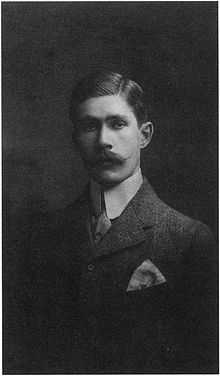 Portrait, 1905 | |
| Born |
July 23, 1881 Villanova, Pennsylvania |
| Died | June 15, 1952 (aged 70) |
| Nationality | American |
Albert Eugene Gallatin wrote about, collected, exhibited, and created works of art. Called "one of the great figures in early 20th-century American culture,"[1] he was a leading proponent of nonobjective and later abstract and particularly Cubist art whose "visionary approach" in both collecting and painting left "an enduring impact on the world of modern art."[2]
Early life and education
Gallatin was born in 1881 into a wealthy and socially prominent family. Showing a youthful interest in art and literature, he began to collect works by Max Beerbohm, Aubrey Beardsley, and James McNeill Whistler while still in his teens. The common element in these purchases was a preference for works that he saw as possessing a harmonious, refined, and decorative nature, rather than a naturalistic or literal one. He appreciated their aesthetic over their narrative content and their intrinsic over their didactic or utilitarian value.[2][3][4][5]
As he collected art, he also began to write about it. For the two decades following the turn of the century, Gallatin produced a constant stream of articles, small monographs, and books of engraved plates.[6] Between 1900 and 1910 most of these concerned Beardsley and Whistler. In examining their drawings and paintings he sought to find out what gave these works enduring value as opposed to superficial and temporary popularity. To him, their excellence showed in elegance of line and quality of design.[7] He also drew attention to what he called a "decorative feeling" in works by these two artists in contrast to what he considered to be the less aesthetic realism of Degas and Millet.[4][8] He maintained that modern art did not become popular because it was good, but because it scandalized. For example, in 1902 he wrote that Beardsley's drawings attracted notice by their shocking distortion of perspective and proportion and their escape from artistic conventions. Because their true value was not readily apparent, he believed that only connoisseurs along with Beardsley's fellow artists could fully appreciate them.[9][10] In another article, he called Whistler an artist "whose work must remain more or less incomprehensible to the general public."[11] He also wrote that the best art was created solely for its own sake. He wrote of Whistler's "unflinching devotion to beauty" and freedom from "commercialism, vulgarity, and the spirit of gain."[12][13] Gallatin said Whistler's subjects were never ugly or lacking taste. In his view, Whistler was not a realist because he never descended to the obvious or commonplace.[14]
When his father died in 1902, Gallatin became head of a family consisting of himself, two sisters, and their mother. As a member of New York's social elite he gave and attended high-profile dinners, dances, weddings, and benefits. His name appeared frequently in the press as a result these activities and also as a result of his pioneering affection for automobiles and motor sport.[2][4] His inheritance made it unnecessary for him to work for a living and he chose not to follow the lead of other members of his class by engaging in banking, stock brokerage, or other professional occupation. Instead, he continued to collect art and to enhance his reputation as an art connoisseur by his writings.
During the years leading up to the First World War he became increasingly interested in American artists such as the illustrator, Otho Cushing, the pleinair painter, Frederick Frieseke, and the painter of interiors, Walter Gay.[14] He also acquired and wrote about artists associated with the Ashcan School—Everett Shinn, William Glackens, Ernest Lawson, and John Sloan as well as other young American artists, including John Marin and Boardman Robinson.[15] While the drawings, paintings, and prints of these artists appear to have little in common with the work of Beardsley and Whistler, he saw in them a similar feeling for form, elegance of line, and "entire freedom from all taint of the academic."[14] Glackens, he wrote, was like Whistler in his originality, his great color sense, and his ability to bring subjects to life.[16] Shinn's paintings revealed to him a "personal expression of the artist's genius" and he also saw in them a "decorative instinct" that he admired in virtually all the art he collected.[14] He was pessimistic about the capacity of museums and government agencies to support young American artists and believed they would be best served by individual art lovers, collectors, and "enlightened" critics.[2][17][18]

Gallatin served in World War I as a member of a naval reserve unit and directed two civilian groups: a federal government committee on exhibitions of art propaganda and a municipal committee that encouraged artists to make posters supporting the war effort.[19] This involvement led to a book, Art and the Great War, (1919) in which Gallatin discussed war-related art in the allied nations, giving many examples of paintings, drawings, posters, caricatures, and prints that he admired.[19][20] In 1918, with Duncan Phillips and Augustus Vincent Tack, he organized an exhibition, the Allied War Salon of New York.[2][4][21] The works in this show were almost all traditionally representational. The exceptions were paintings by a British artist, C.R.W. Nevinson, whose work at this time could be described as a cubist version of futurism. Nevinson's French Troops Resting of 1916, was exhibited at the Keppel & Co. galleries in 1919 and was probably included in the 1918 show.[22] It and similar works of his are said to have been Gallatin's first introduction to this aspect of modernism.[4]
Art collecting: 1920s
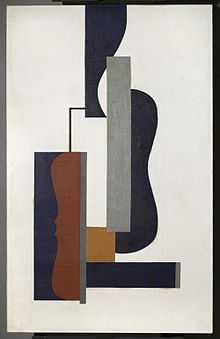
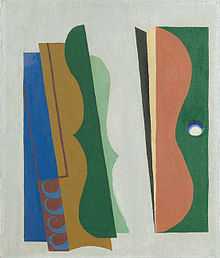
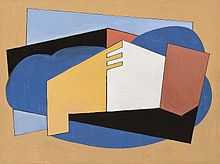
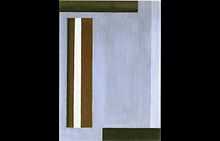
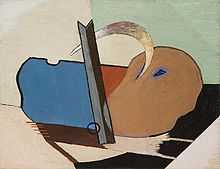
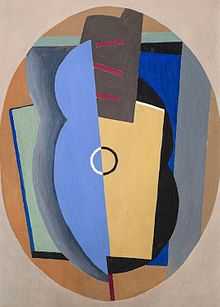
In 1916, Gallatin had dismissed modernists in general and cubists in particular as immature. He thought their work to be half-baked, mediocre, and depressing.[23][24] By the middle of the 1920s, through the influence of Nevinson, of the critic, Clive Bell, and of the authors of articles in The Arts magazine, he had thoroughly revised his opinions.[4] Nevinson showed that cubism was not a gimmick, but a technique that emerged naturally from the art of its time.[22] Bell articulated a formalist aesthetic that coincided with Gallatin's belief that art was not good because of its realism, but because the two-dimensional space of the painting, drawing, or print possessed a satisfying composition, line, shape, color, and texture. Pictorial representation, trueness to life, and the illusion of depth were secondary concerns. Bell also voiced an opinion that seems to have been latent in Gallatin's thought as well: good art is well-ordered rather than chaotic and it proceeds from the artist's thought processes and intuitive sense of rightness more than his emotions.[25] William Zorach and other authors of articles in The Arts discussed an art of "purely abstract forms and colors" that, through an elimination "of everything not vitally necessary," produced a true art. The difficulty of judging what is a "masterpiece" and what is an "abortion" is no different for abstract than it is for representational art: it takes experience, careful study, and "listening to one's inner response."[26][27]
In the years between 1920 and 1926 Gallatin became a member of the modernist Société Anonyme[28] and was introduced to the influential artist-critic Jacques Mauny who soon became his friend and advisor.[4] Mauny introduced him to Pablo Picasso and other painters and to the dealer and author, Daniel-Henry Kahnweiler. These men helped further to shape his growing appreciation for cubism and Mauny, in particular, helped him revamp his collection by adding paintings by artists such as Cézanne and Picasso and selling ones that no longer suited his taste.[2][4] In the mid-1920s Gallatin studied art with the artist and teacher, Robert Henri, and in 1926 produced some small still lifes and mythology-themed paintings which have been described as having "broad areas of open space broken up by clusters of oddly shaped forms."[19] His interest in cubism deepened and he added works to his collection by Georges Braque and Juan Gris.[2][21]
At least partly in response to articles by Forbes Watson in The Arts and Henry McBride in The Dial, Gallatin began planning for a public gallery based on his collection of modern art.[4] Early in 1927, as a result of a family connection with New York University, he was able first to organize a small show and, in December of that year, to open his Gallery of Living Art in the south study hall of that university's main building on Washington Square.[4] The gallery has been called the first museum devoted exclusively to modern art.[2][4][5] (The Phillips Memorial Collection, opened in 1920, might also lay claim to that distinction but for the fact that it was not exclusively modernist.[29]) Consisting almost entirely of works from Gallatin's collection and assembled with help from the critic, Henry McBride, there were, at its opening, paintings and works on paper by twenty-four artists, both American and French. In addition to the forty-three of his own, Gallatin included fifteen borrowed works.[30] There was no entry fee and from the beginning it was seen as place for artists to use as well as the general public.[4][31]
Art collecting: 1930s
The composition of the Gallery of Living Art was informal and fluid, changing frequently as Gallatin added to his collection or simply wished to revise the display. Somewhat conservative at first, it grew to include major paintings in the cubist, neo-plasticist, and constructivist style by artists such as Picasso, Braque, Gris, Fernand Léger, Piet Mondrian, Jean Hélion, and El Lissitzky as well as ones in the surrealist style by Joan Miró, Jean Arp, and André Masson.[4][5] Gallatin hung the gallery with the few large paintings occupying wall space by themselves. By the mid-1930s, these large paintings included Picasso's Three Musicians (1921), Léger's The City (1919), and Miró's Painting (Fratellini).[32] Most of the collection consisted of small works making it easy for moderately-sized ones, such as Miró's Dog Barking at the Moon (1926) and Mondrian's Composition with Blue and Yellow (1932), to attract the viewer's notice.[2][5] During the 1930s Gallatin continued to receive advice from Jacques Mauny. He also was aided by a succession of friends and acquaintances beginning with Henry McBride (1927–32), followed by Robert Delaunay (1932–33) and then Jean Hélion and George L.K. Morris (1933-ca. 1940). Following his own inclination and their influence, he purged figurative works in favor of abstraction and emphasized non-objective works over ones having identifiable subjects.[2][4][33]
In 1936 Gallatin changed the name of the gallery to Museum of Living Art. By this time both the Whitney Museum and the Museum of Modern Art had opened to the public and Gallatin's museum was credited as having the collection that most interested, and influenced, young New York artists such as Arshile Gorky, Philip Guston, Robert Motherwell, and the de Koonings.[1][2][4][34]
In 1938 Life Magazine profiled Gallatin and the Museum in a photo spread entitled "Albert Gallatin's Great-Grandson Sponsors a Museum of Abstract Art." The images included a caricature by of Gallatin by Léger, a photo of a set of panels in the museum, major works in the collection, and copies of photographs that Gallatin had taken of prominent Parisian artists.[32]
Art work: 1930s-1940s
In February 1936 Gallatin resumed painting. He had been deliberate and unhurried in his collecting, acquiring first small pieces on paper and, on becoming comfortable with an artist's work, gradually moving on to larger oil paintings. Similarly, he took many months to work up his own easel productions from conception to finished state. The works themselves were uniformly non-objective. At the time critics saw them as cerebral and "euclidean."[34][35][36] In 1938, Edward Alden Jewell, the perceptive critic for the New York Times called them "pure" and, making an early use of the term, "non-objective" (the quote marks are his).[37][38] They have since been seen as "sensitively realized abstractions," structural designs of an architectural nature, imbued with "subtle structural strength," and "endlessly inventive." The term "decorative" was also applied to them, both in a pejorative sense and one more in keeping with his own use of the term, which connoted harmony and a higher plane of taste.[4][39][40]
In 1936 paintings of his were included in a show at the Galerie Pierre, Paris. Previously exhibited Paul Reinhardt Galleries in New York, it was then called "Five Contemporary American Concretionists" and lacked his work.[2][34][39][41]
He was generally reticent about his work but in 1938 told an interviewer that he tried to strip his painting down to the essentials of art.[32][42] The statement fits with his writings on the artists whose work he admired. He felt art was best when least connected to things in the world: pure line, color, shape, texture, and tone.[4][34] In keeping with this attitude, he rarely gave his paintings distinctive names, leaving them untitled or calling them simply "Composition" or "Abstraction."
In 1937 Gallatin joined the American Abstract Artists group (to which Morris already belonged) and began to give it financial support. The group was formed by a loose assembly of artists to help educate the public about abstract art and to hold exhibitions.[2][4] The following year, at the Georgette Passedoit Gallery in New York, he had his first solo exhibition[37] and also sold a painting, Composition (1938), to the Museum of Modern Art.[2][43] During the summer of that year he made his last trip abroad and thereafter enlarged his collection without traveling.[4]
In 1939 he exhibited with two other members of American Abstract Artists—Morris and Charles G. Shaw—at the gallery of Jacques Seligmann in New York. Since all three were non-objective painters and all were wealthy New Yorkers, they came to be called the "Park Avenue Cubists."[2][35]
From that time forward, non-objective art in general and Gallatin's art in particular became increasingly accepted within the New York art world. In 1941 he was said to paint with taste, fine touch, and inventive skill.[44] In 1945 Edward Alden Jewell referred to him as an "impressive exponent of this form of abstraction" whose "work is refreshingly individual," "vigorous and expertly painted,"[45][46] and in 1947 he wrote that Gallatin was secure in his position as "uncompromising nonobjectivist" whose work was "all neatness and smooth reasonable decorum."[40][47] In 1942 Gallatin was referred to as New York's "abstract king" in a profile that appeared in the "Talk of the Town" section of the New Yorker magazine.[48]
Later life and work
During the 1940s Gallatin continued to exhibit his own paintings and organize exhibits of others. In 1942 he put together a show devoted to American women, including Morris's wife, Suzy Frelinghuysen, as well as Alice Trumbull Mason and Esphyr Slobodkina.[4] That same year New York University informed him that he had to close the Museum of Living Art so that the space it occupied could be repurposed as a wartime economy measure. Greatly disappointed, Gallatin accepted an offer from the Philadelphia Museum of Art to provide a home for it. Within a few months 175 works from his collection were moved to Philadelphia and a few were donated to the Berkshire Museum in Pittsfield, Massachusetts, to which Morris and Frelinghuysen were connected.[4][49][50] During the remainder of the 1940s, until his death in 1952, he continued to paint, promote, and collect non-objective art. In 1952 was given a one-man retrospective exhibition at the Rose Fried Gallery, New York.[51] On his death he dispersed his remaining works of art to the New-York Historical Society, the Museum of the City of New York, the National Gallery of Art, and his two sisters.[52] At the end of his life the style of painting that he had championed was falling out of favor as abstract-expressionist art achieved its first critical recognition. Since that time it has regained critical attention and public appeal and is seen at least by some as influencing the minimalist and hard-edge artists who came into prominence in the 1960s[53] as well as younger artists such as Sarah Morris and Mai Braun.[54]
Family
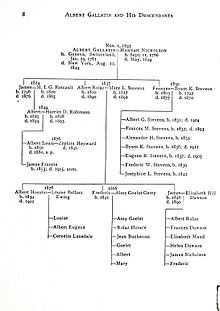
Albert was a common given name in the Gallatin family. Gallatin's great-grandfather was Albert Gallatin (1761-1849), Secretary of the Treasury under presidents Jefferson and Madison and one of founders of New York University.[55] His second son was named Albert Rolaz (1800-1890) and Albert Rolaz's first son, Gallatin's father, was named Albert Horatio. Gallatin had two uncles named Albert, one, surnamed Gallatin, had died before his birth, and the other, surnamed Stevens, died in 1904. Two other uncles, Frederic and James Gallatin had sons named Albert. These two cousins were sometimes confused with Gallatin. Like Gallatin, both lived in New York and both were sufficiently prominent to receive frequent mentions in the local press. James's son was formally called Albert Rolaz Gallatin but was often called just Albert Gallatin. A stock broker and director of many companies, he was born October 7, 1939, and died March 13, 1939.[56][57] Frederic's son was simply Albert (born January 8, 1880, died September 1, 1965).[56] He was an archeologist whose speciality was ancient Greek vases and Egyptian art.[58][59] He was co-author of a work, Corpus Basorum Antiquorum (1925), which is sometimes wrongly attributed to Gallatin.[60] Both cousins were born and died in New York and both married. Albert Gallatin, the archeologist, had four children, two daughters and two sons. One of the sons was named Albert Frederic Gallatin. He was born July 28, 1915, and died July 1, 1996. The stock broker had no children.[56]
Gallatin's father, Albert Horatio Gallatin, was born March 7, 1839, and died March 25, 1902.[56] A lifelong resident of New York, he was trained in medicine at New York University, served as a surgeon in the Civil War, and became a professor of chemistry at NYU.[61] Gallatin's mother was Louise Bedford Ewing. She was born in Maryland, August 8, 1843, died in New York, December 3, 1922.[56][62] Gallatin's older sister, Louise, was born May 1880, and died February 8, 1970.[56][63] She married Charles Merrick Gay, professor of architecture, University of Pennsylvania, and director of the Franklin Institute, Philadelphia, Pennsylvania.[64] Gallatin's younger sister, Cornelia Lansdale Gallatin (February 14, 1884 – March 26, 1973), married Alfred FitzRoy Anderson (July 13, 1882 – November 15, 1965). He was a member of New York society whose charity work involved disabled veterans and repeal of Abolition.[65][66]
Gallatin himself was born on July 23, 1881, in the country house of his maternal grandmother, Cornelia Lansdale Ewing, which was located in Villanova, Pennsylvania. He attended schools there and in New York, including the Cutler preparatory school and the New York Law School both in New York City. He did not take the bar exam, however, and later said "I don't know why the devil I did it. I think an abstract artist is of more value to the community than a lawyer."[4][19] As he matured he mixed freely in New York society, frequenting the opera and charity balls. In 1907 he co-founded the Motor-Car Touring Society. He belonged to the Union Club, the Pilgrims Society, the Society of Colonial Wars, and was the sole American member of the French branch of the Society of the Cincinnati.[2] After the United States entered World War I he signed up as an Ensign in the Naval Coast Defense Reserve.[67] He also chaired two committees: the Committee on Exhibitions and Pictorial Publicity of the United States Government Committee on Public Information and the Committee on Arts and Decorations of the Mayor's Committee on National Defense.[68] The first dealt with art propaganda and led to the publication of his book, Art and the Great War (New York, E.P. Dutton & Company, 1919). The second advised artists on contributing work to the war effort. In December, 1918, Gallatin organized an Allied War Salon under the auspices of both committees. The exhibition took place at the American Art Association, Madison Square South, New York. Duncan Phillips of the American Federation of Arts and Augustus Vincent Tack of the Liberty Loan Committee were co-organizers. It included a large number of paintings, drawings, posters, and other works by the official and unofficial artists of the allied countries.[69] Gallatin was a trustee of New York University and a patron of and donor to numerous art organizations including New York University, the Museum of Modern Art, American Abstract Artists, Museum of the City of New York, and the Berkshire Museum.
Contemporaries said Gallatin was conservative, dandified, patrician, and sophisticated. He dressed elegantly, was tall, sober, and bespectacled. His demeanor was formal and few friends were able to see the side of his personality that was relaxed, humorous, and informal. He was hardworking and firmly dedicated to his life's work. He was said to sleep on a hard, narrow bed, belonged to Napoleon's brother Joseph. There was never any scandal attached to his name and he never married.[4]
Collections
The main source for this list is the web site called Museum Angel.[70]
- Art Institute Of Chicago, Chicago, Illinois
- Heckscher Museum, Huntington, New York
- High Museum Of Art, Atlanta, Georgia
- Metropolitan Museum of Art, New York
- Pennsylvania Academy Of The Fine Arts School and Museum, Philadelphia, Pennsylvania
- Philadelphia Museum of Art, Philadelphia, Pennsylvania
- Princeton University Art Museum, Princeton, New Jersey
- University of Florida - Samuel P. Harn Museum Of Art, *Gainesville, Florida
- Weatherspoon Art Museum, Greensboro, North Carolina
- Whitney Museum of American Art, New York
Writings
Articles and monographs, in chronological order
- 1900 List of Drawings by Aubrey Beardsley. New York, De Vinne Press, 1900 (one hundred copies)
- 1902 Aubrey Beardsley as a Designer of Book-plates. Boston, C.E. Peabody, 1902 (reprinted from Reader Magazine, December 1902)
- 1902 "Note on the Literary Element in Beardsley's Art," The Critic, Vol. 41 (Dec. 1902), pp. 561–569
- 1902 "Aubrey Beardsley; Two Recent Estimates of the Work of the Artist," a book review by A.E. Gallatin in New York Times, September 6, 1902, page BR5
- 1903 "A Note on Otho Cushing's Drawings," Brush and Pencil, Vol. 11, No. 5 (Feb., 1903), pp. 351–355
- 1903 "A Whistler Bibliography: Prepared for The New York Times Saturday Review," New York Times, Jan. 3, 1903
- 1903 Aubrey Beardsley’s Drawings: a Catalogue and a List of Criticisms. New York, Godfrey A. S. Wieners, 1903
- 1904 Whistler's Art Dieta and Other Essays. Boston, Charles E. Goodspeed, 1904
- 1904 "Whistler. The Appreciation of His Art by Messrs. T. R. Way and G. R. Dennis by A.E. Gallatin," a book review in New York Times, January 2, 1904, p. BR12
- 1905 "Some Notable Art Criticism," The Critic (vol. 47, July–December, 1905, pp 259–260
- 1907 Whistler; Notes and Footnotes and Other Memoranda. New York, The Collector and Art Critic Co., 1907
- 1910 Modern Art at Venice, and Other Notes. New York, J.M. Bowles, 1910
- 1910 "Whistler's Pastels," Art and Progress, Vol. 2, No. 1 (Nov., 1910), pp. 8–10
- 1911 "A New Etching by Zorn," Art and Progress, Vol. 2, No. 9 (Jul., 1911), p. 261
- 1911 "The Graphic Artists of the XIXth Century," Art and Progress, Vol. 2, No. 12 (Oct., 1911), pp. 352–354
- 1911 "The International Society," Art and Progress, Vol. 2, No. 11 (Sep., 1911), pp. 325–326
- 1911 "The Pastellists," Art and Progress, Vol. 2, No. 5 (Mar., 1911), pp. 142–144
- 1911 "The Sculpture of Prince Paul Troubetzkoy," Art and Progress, Vol. 2, No. 7 (May, 1911), pp. 208–209
- 1911 "The Winslow Homer Memorial Exhibition," Art and Progress, Vol. 2, No. 6 (Apr., 1911), pp. 167–169
- 1912 "Max," Art and Progress, Vol. 3, No. 4 (Feb., 1912), pp. 478–480
- 1912 "The Paintings of Frederic C. Frieseke," Art and Progress, Vol. 3, No. 12 (Oct., 1912), pp. 747–749
- 1913 Portraits and Caricatures of James McNeill Whistler, an Iconography. New York, John Lane Company, 1913
- 1913 Whistler's Pastels and Other Modern Profiles. New York, John Lane Company, 1913
- 1913 "An Exhibition of Women's Portraits by Modern Artists," Art and Progress, Vol. 4, No. 8 (Jun., 1913), pp. 983–988
- 1913 "Mr. Walter Gay's Interiors," Art and Progress, Vol. 4, No. 9 (Jul., 1913), pp. 1023–1027
- 1914 "Salon des Humoristes," Art and Progress, Vol. 5, No. 5 (Mar., 1914), pp. 175–177
- 1916 Notes on Some Rare Portraits of Whistler. New York, John Lane company, 1916
- 1916 "The Sculpture of Paul Manship," The Metropolitan Museum of Art Bulletin, Vol. 11, No. 10 (Oct., 1916), pp. 218+220-222
- 1916 "William Glackens," The American Magazine of Art, Vol. 7, No. 7 (May, 1916), pp. 261–263
- 1916 Certain Contemporaries; a Set of Notes in Art Criticism. New York, John Lane Company, 1916
- 1917 Paul Manship. New York, John Lane Company, 1917
- 1917 Portraits of Albert Gallatin. Boston, privately printed, 1917
- 1918 Portraits of Whistler: a Critical Study and an Iconography. New York, J. Lane, 1918
- 1919 Art and the Great War. New York, E.P. Dutton & Company, *1919
- 1919 "The Paintings of Max Kuehne," The International Studio, vol. 68 (Aug. *1919), p. xxvii
- 1920 Paintings of French Interiors (edited with an introduction and notes on the plates, by Albert Eugene Gallatin). New York, E. P. Dutton and company, 1920
- 1921 Modern Fine Printing in America; an Essay. New York, privately printed, 1921
- 1922 American Water-colourists. New York, E. P. Dutton & Company, 1922
- 1924 Gaston Lachaise; Sixteen Reproductions in Collotype of the Sculptor's Work. New York, Merrymount Press, E.P. Dutton & Company, 1924
- 1924 Max Kuehne. Sixteen reproductions of the artist's work; edited with a foreword by A. E. Gallatin. New York, E. P. Dutton & company, 1924
- 1925 John Sloan, Edited with an Introduction by A. E. Gallatin. New York, E.P. Dutton & company, 1925
- 1933 Gallery of Living Art. New York, 1933
- 1934 Gallatin Iconography. Boston, privately printed, 1934
- 1939 Recent Paintings by Gallatin, Morris, Shaw. New York, Jacques Seligmann & Co., 1939
- 1940 Museum of Living Art: A. E. Gallatin Collection. New York, New York University, 1940
- 1943 Georges Braque: Essay and Bibliography. New York, Wittenborn and Company, 1943 (as editor)
- 1950 Pursuit of Happiness; the Abstract and Brief Chronicles of the Time. New York, 1950
- 1952 Bibliography of the Works of Max Beerbohm. Cambridge, Harvard University Press, 1952
- 1963 Of Art: Plato to Picasso, Aphorisms and Observations. New York, Wittenborn, 1963
Monographs, alphabetically by title
- American Water-colourists. New York, E. P. Dutton & Company, 1922
- Art and the Great War. New York, E.P. Dutton & Company, 1919
- Aubrey Beardsley as a Designer of Book-plates. Boston, C.E. Peabody, 1902
- Aubrey Beardsley’s Drawings: a Catalogue and a List of Criticisms. New York, Godfrey A. S. Wieners, 1903
- Bibliography of the Works of Max Beerbohm. Cambridge, Harvard University Press, 1952
- Certain Contemporaries; a Set of Notes in Art Criticism. New York, John Lane Company, 1916
- Gallatin Iconography. Boston, privately printed, 1934
- Gallery of Living Art. New York, 1933
- Gaston Lachaise; Sixteen Reproductions in Collotype of the Sculptor's Work. New York, Merrymount Press, E.P. Dutton & Company, 1924
- Georges Braque: Essay and Bibliography. New York, Wittenborn and Company, 1943 (as editor)
- John Sloan, Edited with an Introduction by A. E. Gallatin. New York, E.P. Dutton & company, 1925
- List of Drawings by Aubrey Beardsley. New York, De Vinne Press, 1900 (one hundred copies)
- Max Kuehne. Sixteen reproductions of the artist's work; edited with a foreword by A. E. Gallatin. New York, E. P. Dutton & company, 1924
- Modern Art at Venice, and Other Notes. New York, J.M. Bowles, 1910
- Modern Fine Printing in America; an Essay. New York, privately printed, 1921
- Museum of Living Art: A. E. Gallatin Collection. New York, New York University, 1940
- Notes on Some Rare Portraits of Whistler. New York, John Lane company, 1916
- Of Art: Plato to Picasso, Aphorisms and Observations. New York, Wittenborn, 1963
- Paintings of French Interiors (edited with an introduction and notes on the plates, by Albert Eugene Gallatin). New York, E. P. Dutton and company, 1920
- Paul Manship. New York, John Lane Company, 1917
- Portraits and Caricatures of James McNeill Whistler, an Iconography. New York, John Lane Company, 1913
- Portraits of Albert Gallatin. Boston, privately printed, 1917
- Portraits of Whistler: a Critical Study and an Iconography. New York, J. Lane, 1918
- Pursuit of Happiness; the Abstract and Brief Chronicles of the Time. New York, 1950
- Recent Paintings by Gallatin, Morris, Shaw. New York, Jacques Seligmann & Co., 1939
- Syracusan Dekadrachms of the Euainetos Type. Cambridge, MA: Harvard University Press, 1930
- Whistler; Notes and Footnotes and Other Memoranda. New York, The Collector and Art Critic Co., 1907
- Whistler's Pastels and Other Modern Profiles. New York, John Lane Company, 1913
- Whistler's Art Dieta and Other Essays. Boston, Charles E. Goodspeed, 1904[71]
Articles, alphabetically by title
- "Aubrey Beardsley; Two Recent Estimates of the Work of the Artist," a book review by A.E. Gallatin in New York Times, September 6, 1902, page BR5
- "An Exhibition of Women's Portraits by Modern Artists," Art and Progress, Vol. 4, No. 8 (Jun., 1913), pp. 983–988
- "The Graphic Artists of the XIXth Century," Art and Progress, Vol. 2, No. 12 (Oct., 1911), pp. 352–354
- "The International Society," Art and Progress, Vol. 2, No. 11 (Sep., 1911), pp. 325–326
- "Max," Art and Progress, Vol. 3, No. 4 (Feb., 1912), pp. 478–480
- "Mr. Walter Gay's Interiors," Art and Progress, Vol. 4, No. 9 (Jul., 1913), pp. 1023–1027
- "Ernest Lawson," The International Studio, Vol. 59, (Jul., 1916), pp. 14
- "A New Etching by Zorn," Art and Progress, Vol. 2, No. 9 (Jul., 1911), p. 261
- "A Note on Otho Cushing's Drawings," Brush and Pencil, Vol. 11, No. 5 (Feb., 1903), pp. 351–355
- "Note on the Literary Element in Beardsley's Art," The Critic, Vol. 41 (Dec. 1902), pp. 561–569
- "The Paintings of Max Kuehne," The International Studio, vol. 68 (Aug. 1919), p. xxvii
- "The Pastellists," Art and Progress, Vol. 2, No. 5 (Mar., 1911), pp. 142–144
- "The Paintings of Frederic C. Frieseke," Art and Progress, Vol. 3, No. 12 (Oct., 1912), pp. 747–749
- "Salon des Humoristes," Art and Progress, Vol. 5, No. 5 (Mar., 1914), pp. 175–177
- "The Sculpture of Paul Manship," The Metropolitan Museum of Art Bulletin, Vol. 11, No. 10 (Oct., 1916), pp. 218+220-222
- "The Sculpture of Prince Paul Troubetzkoy," Art and Progress, Vol. 2, No. 7 (May, 1911), pp. 208–209
- "Some Notable Art Criticism," The Critic (vol. 47, July–December, 1905, pp 259–260
- "Whistler. The Appreciation of His Art by Messrs. T. R. Way and G. R. Dennis by A.E. Gallatin," a book review in New York Times, January 2, 1904, p. BR12
- "A Whistler Bibliography: Prepared for The New York Times Saturday Review," New York Times, Jan. 3, 1903
- "Whistler's Pastels," Art and Progress, Vol. 2, No. 1 (Nov., 1910), pp. 8–10
- "William Glackens," The American Magazine of Art, Vol. 7, No. 7 (May, 1916), pp. 261–263
- "The Winslow Homer Memorial Exhibition," Art and Progress, Vol. 2, No. 6 (Apr., 1911), pp. 167–169
References
Notes
- ↑ 1.0 1.1 Michael Kimmelman (1992-08-21). "In Massachusetts, 2 Early American Abstract Artists". New York Times. p. C23.
- ↑ 2.0 2.1 2.2 2.3 2.4 2.5 2.6 2.7 2.8 2.9 2.10 2.11 2.12 2.13 2.14 2.15 Zenobia Grant Wingate. "Albert Gallatin". The Caldwell Gallery. Retrieved 2014-08-06.
- ↑ "Albert Eugene Gallatin". nyu.edu. 2002. Retrieved 2014-08-06.
- ↑ 4.0 4.1 4.2 4.3 4.4 4.5 4.6 4.7 4.8 4.9 4.10 4.11 4.12 4.13 4.14 4.15 4.16 4.17 4.18 4.19 4.20 4.21 4.22 Stavitsky, Gail (Winter–Spring 1994). "The A. E. Gallatin Collection: An Early Adventure in Modern Art". Philadelphia Museum of Art Bulletin 89 (379/380): 1+4–47. JSTOR 3795466.
- ↑ 5.0 5.1 5.2 5.3 Joan M. Marter (2011). The Grove Encyclopedia of American Art. Oxford University Press. pp. 301–302. ISBN 978-0-19-533579-8.
- ↑ See, below, the list of Gallatin's writings in chronological order.
- ↑ "Aubrey Beardsley; Two Recent Estimates of the Work of the Artist". New York Times. 1902-09-06. p. BR5.
The aesthetic qualities of his line, the perfect arrangements of his masses of black, the literary element in his work—these will always appeal to the artist and connoisseur. But there is nothing—such as mere "prettiness"—in his drawings to make them popular, unless they are enjoyed as a piece of caviar would be.
- ↑ Gallatin, Albert Eugene (December 1902). "Note on the Literary Element in Beardsley's Art". The Critic 41: 561–569. Retrieved 2014-08-07.
- ↑ Albert Eugene Gallatin (1902). Aubrey Beardsley as a designer of book-plates. Elkin Mathews (London); Charles E. Peabody & Co. (Boston).
- ↑ "The really essential viewpoint for considering Beardsley's drawings is the purely technical one of the artist and the connoisseur. The Decorative qualities in his work have never been surpassed by any artist whose work has been in black and white. Beardsley is primarily an "artist's artist," and the qualities of his wonderful and beautiful line and perfect arrangement of his masses are the elements in his work which will make it immortal. The aesthetic qualities in his drawings are not those which mean mere popularity. It is true his drawing had a greater vogue than those of any other artist of his age, but just why they had seems difficult of explanation, unless, as one critic holds, his ignoring of perspective and proportion, and his freedom, to a certain extent, of convention, caused his works to meet with a succès de scandale." (Aubrey Beardsley as a Designer of Book-plates. Boston, C.E. Peabody, 1902, pp. 3-5)
- ↑ Gallatin, Albert Eugene (July–December 1905). "Some Notable Art Criticism". The Critic 47: 259–260.
- ↑ Gallatin, Albert Eugene (March 1912). "Whistler's Pastels, and Modern Profiles". Art and Progress 3 (5): 538.
- ↑ "Into commercialism, vulgarity, and the spirit of gain, in which realism and ugliness were two of her artist's gods, came Whistler with his unflinching devotion to beauty-beauty for its own sake. In all of Whistler's works—paintings, watercolors, pastels, etchings, drypoints, lithographs, drawings—we are instantly impressed by their distinction and elegance: always was Whistler an aristocrat. In the course of his famous lecture on art Whistler said that "We have then but to wait—until, with the mark of the gods upon him—there come among us again the chosen—who shall continue what has gone before." All supremely great works of art are great because of their intrinsic beauty; a masterpiece of Greek sculpture, a piece of old Chinese porcelain, an Italian bronze statuette of the Renaissance, a painting by Velasquez or one by Vermeer may be grouped together with the greatest harmony and unity of purpose; they speak the same language and have everything in common. And with them could be placed a Whistler, for he also "had the mark of the gods upon him." ... unhackneyed subjects treated in an entirely personal way and wonderfully beautiful and alluring; ... drawings are of the greatest artistic importance because more personal than paintings, and personality counts next to genius." ("Whistler's Pastels, and Modern Profiles," Art and Progress, March 1912, p. 9)
- ↑ 14.0 14.1 14.2 14.3 Albert Eugene Gallatin (1907). Whistler: notes and footnotes and other memoranda. The Collector and art critic co.
- ↑ "Davies and Gallatin Exhibitions Open New Year In Art". New York Herald. 1918-01-06. p. 10.
- ↑ Gallatin, Albert Eugene (May 1916). "William Glackens". The American Magazine of Art 7 (7): 261–263.
- ↑ "The painter of originality and talent who turns for support to the State, to the public museums or to organized art societies is doomed to disappointment. If it were not for the support and encouragement of enlightened critics and of amateurs and collectors, the genius of many painters would never reach maturity." (American Water-Colourists by Albert Eugene Gallatin, New York, E. P. Dutton & Company, 1922, pp. xi-x)
- ↑ Albert Eugene Gallatin (1922). American Water-Colourists. New York: E. P. Dutton & Company.
- ↑ 19.0 19.1 19.2 19.3 "Albert Eugene Gallatin". Vered Art Gallery.
- ↑ Albert Eugene Gallatin (1919). Art and the Great War. E.P. Dutton.
- ↑ 21.0 21.1 "Albert Eugene Gallatin". Phillips Collection. Retrieved 2014-08-06.
- ↑ 22.0 22.1 Henry McBride (1919-05-18). "News and Comment in the World of Art". New York Sun. p. 12.
- ↑ Albert Eugene Gallatin (1916). Certain Contemporaries; A Set of Notes in Art Criticism. New York: John Lane Company.
- ↑ "This tardy recognition of a talent so really sincere and genuine [i.e., Ernest Lawson's] is all the more remarkable when we consider the modern fashion of acclaiming and booming the half-baked beginner, of displaying his immature and mediocre efforts, of writing about him at length; that when we consider even the Cubists for a time were taken seriously. Not many painters to-day seem to have the inclination to perfect themselves in their art: they insist upon the short cut, they are content to parade their box of tricks. This is why the average exhibition of modern pictures is so depressing, so tedious." (Certain Contemporaries; A Set of Notes in Art Criticism by Albert Eugene Gallatin, New York, John Lane Company, 1916, p. 15)
- ↑ Bell, Clive (1922). Since Cézanne. London: Chatto & Windus. Retrieved 2014-08-14.
The artist has subordinated his predilections and prejudices, his peculiar way of seeing and feeling, his whims, his fancies and his eccentricities, to a dominant sense of design. Yet the picture is personal. In the first place a picture must be an organic whole, but that whole may be made up of anything that happens to possess the artist's mind.
- ↑ Zorach, William (October 1921). "The New Tendencies in Art". The Arts 2 (1): 10–15.
- ↑ "The essential contribution, of modern art to aesthetics is the building up and development of purely abstract forms and colors. By abstract color I mean colors used for their abstract significance, not realistically, and by abstract form I mean purely geometrical shapes and simplified equivalents of nature,—such as an apple reduced to a circle, a head to an oval,—and the building up of a picture or a piece of sculpture by a combination of these forms, dissected and interlaced, interwoven and developed. Through this re-creation, this building up and eliminating of everything not vitally necessary, is built up a structural whole, is developed a harmony of form and color satisfying the artistic sensibilities of the artist.... There is nothing particularly new in this modern art. It is based upon the same cosmic principles of harmonious balance and relation of lines, forms, colors, volumes as is all true art. An artist must be sensitive to these things either consciously or unconsciously. It is that which causes him to be an artist. How is one to know what is something and what is nothing in modern art, what is a masterpiece and what an abortion? By the same process by which one learns to know what is real and what is not among the pictures of the past. By careful study of various examples, by listening to one's inner response." ("The New Tendencies in Art" by William Zorach, The Arts, Vol. 2, No. 1, October 1921, p. 12)
- ↑ Although he did not remain a member for long.
- ↑ Phillips, Duncan (June 1921). "The Phillips Memorial Art Gallery". The Art Bulletin 3 (4): 147–152.
- ↑ American artists included John Marin, Charles Demuth, Jules Pascin, Charles Burchfield, Walt Kuhn, Alexander Brook, Yasno Kuniyoshi, Karl Knaths, Charles Sheeler, Preston Dickenson, Samuel Halpert, and Marsden Hartley. French artists included Paul Signac, Marquet, Matisse, Etretat, Picasso, Braque, Gris, Othon Friesz, Raoul Dufy, Maurice Dufresne, and Jacques Mauny. (Gallery of Living Art and American Print Makers: Two New Novel Enterprises by Elisabeth L. Cary, New York Times, December 18, 1927, p. X12)
- ↑ Elisabeth L. Cary (1927-12-18). "Gallery of Living Art and American Print Makers: Two New Novel Enterprises". New York Times. p. X12.
- ↑ 32.0 32.1 32.2 "Albert Gallatin's Great-Grandson Sponsors a Museum of Abstract Art". Life 4 (18): 42–45. 1938-05-02. Retrieved 2014-08-14.
- ↑ Stavitsky, Gail (Spring–Summer 1992). "A. E. Gallatin and Robert Delaunay". Source: Notes in the History of Art 11 (3/4): 53–58. JSTOR 23203483.
- ↑ 34.0 34.1 34.2 34.3 Stavitsky, Gail (1993). "A Landmark Exhibition: Five Contemporary American Concretionists, March 1936". Archives of American Art Journal 33 (2): 2–10. JSTOR 557663.
- ↑ 35.0 35.1 Henry McBride (1939-01-31). "Abstract American Art; Three Daring American Ventures Into Forbidden No Man's Land". New York Sun. p. 9.
- ↑ Jerome Klein (1936-03-14). "'Concretionists' Called Tasteful in Their Exhibit". New York Post. p. 11.
- ↑ 37.0 37.1 Edward Alden Jewell (1938-02-26). "Gallatin Showing Abstract Painting: Canvases are Presented at One-Man Exhibition in the Georgette Passedoit". New York Times. p. 7.
- ↑ The term "non-objective" was first used to describe art in a New York Times article of February 3, 1936.("Will Exhibit Art at 75," New York Times, February 3, 1936, p. 14)
- ↑ 39.0 39.1 Grace Glueck (2003-01-24). "Cubists Living in Luxury, Not Bohemian Garrets". New York Times. p. E40.
- ↑ 40.0 40.1 Edward Alden Jewell (1947-04-01). "Museum Displays Non-Objective Art: Abstract Artists Open Annual Event at Riverside". New York Times. p. 13.
- ↑ The five concretionists were Charles Biederman, Alexander Calder, John Ferren, George L.K. Morris, and Charles Green Shaw. In Paris and later in London, Gallatin replaced Calder.
- ↑ "I try to strip painting down to the essentials of art, based on the study of the great old masters, and as a protest against the degenerate 19th Century painting which is interested only in its subject."("Albert Gallatin's Great-Grandson Sponsors a Museum of Abstract Art," Life Magazine, Vol. 4, No. 18, May 2, 1938, p. 42)
- ↑ "Modern Artworks Added by Gallery". New York Times. 1938-10-25. p. 24.
- ↑ "Knoedler Galleries to Show Dutch Art". New York Times. 1945-02-05. p. X9.
- ↑ "Other Shows". New York Times. 1941-04-20. p. X9.
- ↑ [A]t Mortimer Brandt's, we reach the nonobjective end of our week's gamut: a large group of paintings by A.E. Gallatin, who has become an impressive exponent of this form of abstraction. ... Gallatin's work is refreshingly individual. The decorative designs are vigorous and expertly painted, among the high spots being "Composition in Blue," "Construction With Red" and "Paris Studio"..."("Expressionist Art' BY Edward Alden Jewell, New York Times, February 11, 1945, p X8)
- ↑ Yet he added that Gallatin's paintings were beginning to show real-world references: "At Durand-Ruel, Albert Eugene Gallatin is all neatness and smooth reasonable decorum: Gallatin, who had made himself so securely the uncompromising nonobjectivist. But heavenly day what is afoot here? Like Morris, like Shaw, Gallatin appears in process of easing back from the nonobjective into naturalism. It isn't yet a clean sweep, but "Still Life No. 1" and "Miss Glutts" have palpably quitted the non, and their objective seems to be Milton Avery. Will Wonders never cease?"("Museum Displays Non-Objective Art: Abstract Artists Open Annual Event at Riverside" by Edward Alden Jewell, New York Times, April 1, 1947, p. 13)
- ↑ Geoffrey T. Hellman (1942-05-09). "Abstract King". Life: 11–12.
- ↑ Edward Alden Jewell (1943-05-23). "Collections in New Homes". New York Times. p. X10.
- ↑ In both 1937 and 1944 Gallatin donated to Berkshire Museum works he had purchased from members of the American Abstract Artists group.
- ↑ Stuart Preston (1952-04-13). "Chiefly Modern: Paintings by Gallatin—Two Sculptors". New York Times. p. 27.
- ↑ "Gallatin Art Works Given to Museums". New York Times. 1952-07-01. p. 21.
- ↑ "Geometric Abstraction". Thematic Essay; Heilbrunn Timeline of Art History; The Metropolitan Museum of Art. Retrieved 2014-08-18.
- ↑ Andrew M. Goldstein. "What Makes Geometric Abstraction So Exciting?". Artspace. Retrieved 2014-08-18.
- ↑ "Albert Rolaz Gallatin (1800-1890)". RootsWeb's WorldConnect Project: Nicholson. Retrieved 2014-08-09.
- ↑ 56.0 56.1 56.2 56.3 56.4 56.5 "RootsWeb's WorldConnect Project". Retrieved 2014-08-18.
- ↑ "Albert Gallatin, Stock Broker, 70". New York Times. 1939-03-14. p. 27.
He was a pupil of Professor Michael Pupin [At Columbia University]...who considered Mr. Gallatin one of his most brilliant students. Mr. Gallatin abandoned scientific pursuits in 1901 when he helped found the firm of Smith & Gallatin.... In 1912 he married Miss Beatrice Quennell, who survives. They had no children.
- ↑ "Albert Gallatin (1880-1965)". RootsWeb's WorldConnect Project: Nicholson. Retrieved 2014-08-09.
- ↑ "Albert Gallatin, 84, Archaeologist, Dead". New York Times. 1965-09-02. p. 31.
Mr. Gallatin's major fields of interest were ancient Greek vases and coins and Egyptian art. With Joseph Hoppin, he wrote a book on Greek vases, "Corpus Basorum Antiquorum," in 1925.... Mr. Gallatin is survived by his widow, the former Margaret Hoffman Hackstaff; daughters, Mrs. Gallatin Cobb and Mrs. William Aiken; two sons, Albert and James, and a sister, Mrs. W.H. Hoppin.
- ↑ "A. E. Gallatin; Albert E. Gallatin". DICTIONARY OF ART HISTORIANS; A Biographical Dictionary of Historic Scholars, Museum Professionals and Academic Historians of Art. Retrieved 2014-08-18.
- ↑ "Death List of a Day; Albert Horatio Gallatin". New York Times. 1902-03-26. p. 9.
- ↑ "Died; Gallatin". New York Times. 1922-12-06. p. 16.
- ↑ "Died; Gay". New York Times. 1970-02-09. p. 39.
- ↑ "Charles M. Gay". New York Times. 1951-12-19. p. 31.
- ↑ "Deaths: Anderson". New York Times. 1973-03-28. p. 50.
- ↑ "Cornelia Gallatin Engaged to Wed". New York Times. 1923-12-05. p. 19.
- ↑ "A.E. Gallatin Appointed an Ensign". New York Times. 1917-05-12. p. 11.
- ↑ "Will Advise Artists: Committee of Experts Will Aid Painters Seeking War Service". New York Times. 1918-06-21. p. 19.
- ↑ "Museum and Gallery Exhibitions: Art at Home and Abroad: Allied War Salon". New York Times. 1918-10-27. p. 40.
- ↑ "Museums With Paintings By Albert Eugene Gallatin". MuseumAngel.com. Retrieved 2014-08-06.
- ↑ "A.E. Gallatin's Essays". New York Times. 1905-01-07. p. BR16.
The papers originally appeared in The International Studio, The Lamp, The Critic, The Weekly Critical Review of Paris, and The Literary Collector.
Further reading
- A.E. Gallatin Collection, "Museum of Living Art." Philadelphia: Philadelphia Museum of Art, 1954 (first edition: New York University, 1930)
- Balken, Debra Bricker. Albert Eugene Gallatin and His Circle. Exhibition catalogue. Coral Gables, Fla.: Lowe Art Museum, University of Miami, 1986
- Balken, Debra Bricker, and Robert S. Lubar. The Park Avenue Cubists: Gallatin, Morris, Frelinghuysen and Shaw. Aldershot, England: Ashgate, in association with the Grey Art Gallery, NYU, 2002
- D'Harnoncourt, Anne. "A.E. Gallatin and the Arensbergs: Pioneer Collectors of Twentieth-Century Art." Apollo, NS 99, No. 149 (July 1974): 52–61
- Galligan, Gregory. The Cube in the Kaleidoscope: The American Reception of French Cubism, 1918–1938. Ph.D. thesis—Institute of Fine Arts, NYU, 2007
- Larsen, Susan C. "The 'Park Avenue Cubist' Who Went Downtown." Art News 77, No. 10 (December 1978): 80–82
- Stavitsky, Gail. "The Development, Institutionalization, and Impact of the A.E. Gallatin Collection of Modern Art." Ph.D. dissertation, Institute of Fine Arts, New York University, 1990
- Stavitsky, Gail. "A.E. Gallatin's Gallery and Museum of Living Art (1927–1943)." American Art 7, No. 2 (Spring 1993): 47–63
- Stavitsky, Gail. "The A.E. Gallatin Collection: An Early Adventure in Modern Art." Bulletin of the Philadelphia Museum of Art 89 (1994): 3–47
- Wainwright, Alexander D. "A Check List of the Writings of Albert Eugene Gallatin," Princeton University Library Chronicle 14, No. 3 (Spring 1953): 141–51
|